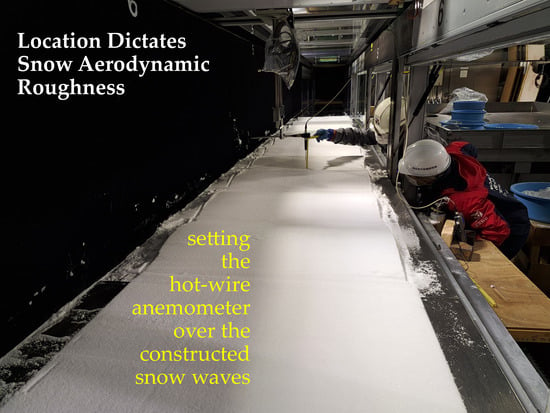Location Dictates Snow Aerodynamic Roughness
Abstract
:1. Introduction
2. Methods
3. Results
4. Discussion
4.1. Experiments and Implications
4.2. Measurements and Additional Data
5. Conclusions
Author Contributions
Funding
Institutional Review Board Statement
Informed Consent Statement
Data Availability Statement
Acknowledgments
Conflicts of Interest
Appendix A. Hot-Wire Anemometer Specification and Assessment
| Air Velocity (m/s) | Temperature (°C) | |
|---|---|---|
| Range | 0.01 to 50.0 m/s | −20 to 70 °C |
| Accuracy | +/−2% of reading or 0.015 m/s (whichever is greater) | +/−0.5 °C |
| Resolution | 0.01 (from 0.01 to 9.99 m/s) | 0.1 °C |
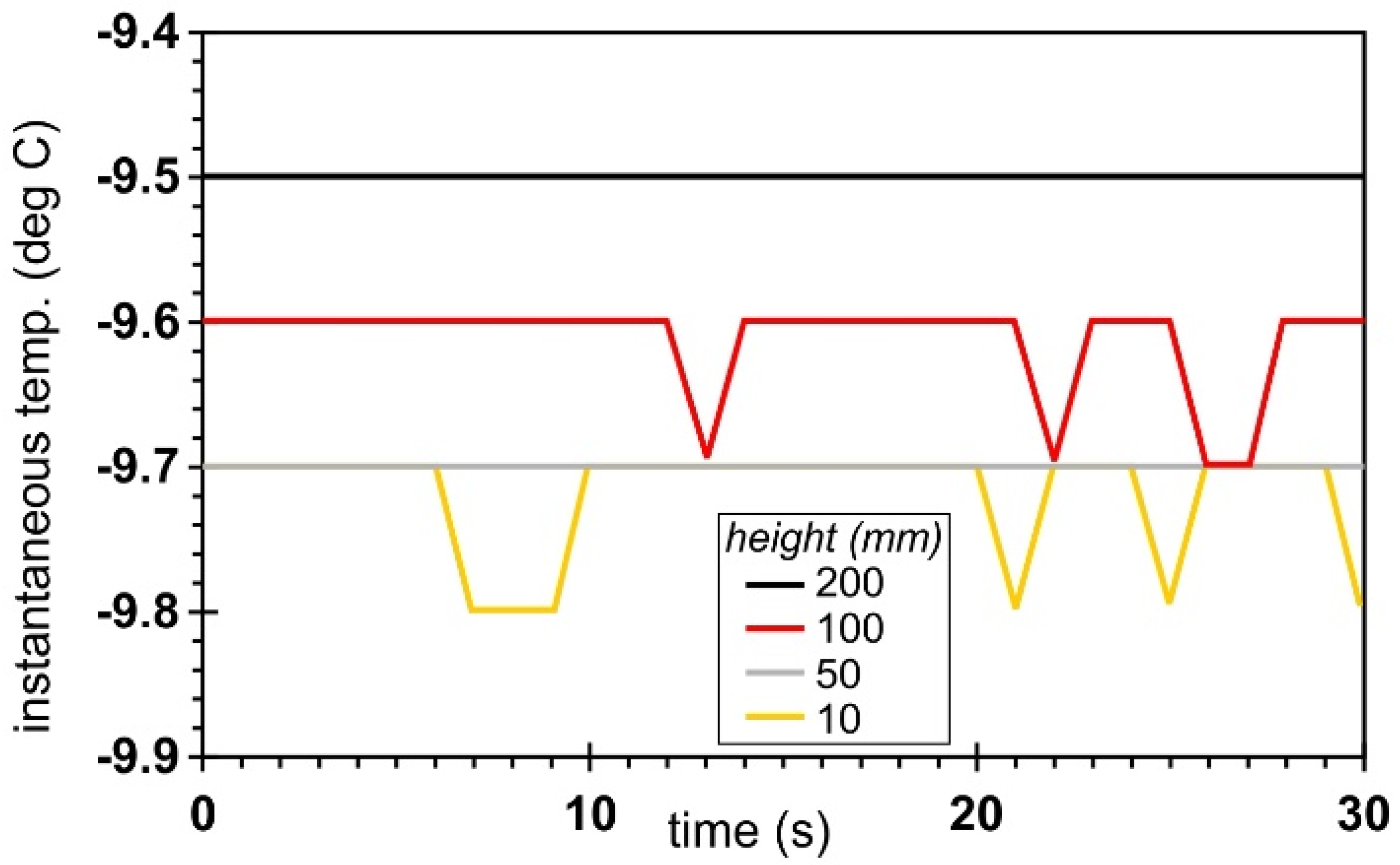

Appendix B. Wind Speed Data Collected during the Experiments and Computed z0 Values
| Height above the Surface (mm) | Flat | Wave Windward | Wave Furrow | Wave Leeward | Wave Trough | Blowing Snow in Wave Windward | Blowing Snow in Wave Furrow | Blowing Snow in Wave Leeward | Blowing Snow in Wave Trough |
|---|---|---|---|---|---|---|---|---|---|
| 10 | 3.64 | 3.93 | 3.3 | 2.54 | 2.8 | 2.92 | 3.03 | 2.73 | |
| 20 | 3.81 | 3.97 | 3.58 | 3.03 | 3.01 | 3.07 | 3.11 | 3.02 | |
| 30 | 3.86 | 3.97 | 3.63 | 3.21 | 3.29 | 3.23 | 3.43 | 3.2 | |
| 35 | 3.45 | 4.18 | 3.18 | ||||||
| 40 | 3.94 | 4.11 | 3.62 | 3.39 | 3.26 | 3.46 | 3.46 | 3.39 | |
| 50 | 3.94 | 4.08 | 3.76 | 3.51 | 3.48 | 3.54 | 3.64 | 3.45 | |
| 60 | 3.95 | 4.07 | 3.7 | 3.51 | 3.6 | 3.71 | 3.77 | 3.62 | |
| 70 | 3.68 | 3.92 | 4.025 | 3.81 | 3.535 | 3.81 | 3.77 | 3.75 | 3.71 |
| 80 | 3.98 | 4.2 | 3.82 | 3.64 | 3.88 | 3.87 | 3.9 | 3.73 | |
| 90 | 4.07 | 4.13 | 3.86 | 3.71 | 3.94 | 3.97 | 3.97 | 3.83 | |
| 100 | 4.18 | 4.275 | 3.88 | 3.74 | 4.06 | 4.13 | 4.15 | 3.94 | |
| 105 | 3.88 | 4.11 | 3.73 | ||||||
| 110 | 4.17 | 4.27 | 4.11 | 3.82 | 4.12 | 4.17 | 4.19 | 4.15 | |
| 120 | 4.14 | 4.34 | 4.1 | 3.83 | 4.23 | 4.28 | 4.35 | 4.18 | |
| 130 | 4.3 | 4.42 | 4.23 | 3.91 | 4.31 | 4.37 | 4.4 | 4.31 | |
| 140 | 4.19 | 4.33 | 4.410 | 4.22 | 3.955 | 4.4 | 4.39 | 4.46 | 4.33 |
| 150 | 4.36 | 4.44 | 4.24 | 4.1 | 4.49 | 4.46 | 4.51 | 4.42 | |
| 160 | 4.42 | 4.54 | 4.32 | 4.18 | 4.54 | 4.45 | 4.54 | 4.45 | |
| 170 | 4.52 | 4.55 | 4.39 | 4.31 | 4.6 | 4.47 | 4.56 | 4.5 | |
| 175 | 4.31 | 4.44 | 4.27 | ||||||
| 180 | 4.51 | 4.61 | 4.47 | 4.41 | 4.61 | 4.55 | 4.6 | 4.53 | |
| 190 | 4.6 | 4.65 | 4.49 | 4.43 | 4.65 | 4.58 | 4.63 | 4.62 | |
| 200 | 4.59 | 4.66 | 4.55 | 4.44 | 4.7 | 4.62 | 4.65 | 4.61 | |
| 210 | 4.49 | 4.67 | 4.55 | 4.57 | 4.42 | 4.75 | 4.63 | 4.72 | 4.65 |
| 245 | 4.57 | 4.76 | 4.69 | 4.69 | 4.64 | 4.79 | 4.71 | 4.76 | 4.73 |
| 280 | 4.66 | 4.78 | 4.72 | 4.75 | 4.74 | 4.85 | 4.76 | 4.75 | 4.77 |
| 315 | 4.69 | 4.78 | 4.75 | 4.77 | 4.78 | 4.86 | 4.78 | 4.74 | 4.76 |
| 350 | 4.68 | 4.77 | 4.75 | 4.78 | 4.78 | 4.85 | 4.76 | 4.72 | 4.76 |
| 385 | 4.67 | 4.76 | 4.74 | 4.78 | 4.77 | 4.84 | 4.76 | 4.83 | 4.74 |
Appendix C. Computation of Anemometric-Based Aerodynamic Roughness Length
References
- Bormann, K.J.; Brown, R.D.; Derksen, C.; Painter, T.H. Estimating snow-cover trends from space. Nat. Clim. Chang. 2018, 8, 924–928. [Google Scholar] [CrossRef]
- Huning, L.S.; AghaKouchak, A. Global snow drought hot spots and characteristics. Proc. Natl. Acad. Sci. USA 2020, 117, 19753–19759. [Google Scholar] [CrossRef] [PubMed]
- Oke, T.R. Boundary Layer Climates, 2nd ed.; Cambridge University Press: Cambridge, UK, 1987; ISBN 0-415-04319-0. [Google Scholar]
- Andreas, E.L. A theory for the scalar roughness and the scalar transfer coefficients over snow and sea ice. Bound.-Layer Meteorol. 1987, 38, 159–184. [Google Scholar] [CrossRef]
- Andreas, E.L.; Jordan, R.E.; Makshtas, A.P. Parameterizing turbulent exchange over sea ice: The ice station weddell results. Bound.-Layer Meteorol. 2005, 114, 439–460. [Google Scholar] [CrossRef]
- Brock, B.; Willis, I.; Sharp, M. Measurement and parameterization of aerodynamic roughness length variations at Haut Glacier d’Arolla, Switzerland. J. Glaciol. 2006, 52, 281–297. [Google Scholar] [CrossRef]
- Fassnacht, S.R.; Williams, M.W.; Corrao, M.V. Changes in the surface roughness of snow from millimetre to metre scales. Ecol. Complex. 2009, 6, 221–229. [Google Scholar] [CrossRef]
- Sanow, J.E.; Fassnacht, S.R.; Kamin, D.J.; Sexstone, G.A.; Bauerle, W.L.; Oprea, I. Geometric versus anemometric surface roughness for a shallow accumulating snowpack. Geosciences 2018, 8, 463. [Google Scholar] [CrossRef]
- Musselman, K.N.; Pomeroy, J.W.; Essery, R.L.H.; Leroux, N. Impact of windflow calculations on simulations of alpine snow accumulation, redistribution and ablation. Hydrol. Process. 2015, 29, 3983–3999. [Google Scholar] [CrossRef]
- Fassnacht, S.R.; Suzuki, K.; Sanow, J.E.; Sexstone, G.A.; Pfohl, A.K.D.; Tedesche, M.E.; Simms, B.M.; Thomas, E.S. Snow Surface Roughness across Spatio-Temporal Scales. Water 2023, 15, 2196. [Google Scholar] [CrossRef]
- Sverdrup, H.U. The eddy conductivity of the air over a smooth snow field. Geofys. Puhlikasjoner 1936, 18, 34–47. [Google Scholar] [CrossRef]
- Andreas, E.L. A relationship between the aerodynamic and physical roughness of winter sea ice. Q. J. R. Meteorol. Soc. 2011, 137, 1581–1588. [Google Scholar] [CrossRef]
- Munro, D.S. Surface roughness and bulk heat transfer on a glacier: Comparison with eddy correlation. J. Glaciol. 1989, 35, 343–348. [Google Scholar] [CrossRef]
- King, J.C.; Anderson, P.S. Heat and water vapor fluxes and scalar roughness lengths over an Antarctic ice shelf. Bound.-Layer Meteorol. 1994, 69, 101–121. [Google Scholar] [CrossRef]
- Lettau, H. Note on aerodynamic roughness-parameter estimation on the basis of roughness-element description. J. Appl. Meteorol. 1969, 8, 828–832. [Google Scholar] [CrossRef]
- Sexstone, G.A.; Clow, D.; Stannard, D.; Fassnacht, S.R. Comparison of methods for quantifying surface sublimation over seasonally snow-covered terrain. Hydrol. Process. 2016, 30, 3373–3389. [Google Scholar] [CrossRef]
- Reba, M.L.; Pomeroy, J.; Marks, D.; Link, T.E. Estimating surface sublimation losses from snowpacks in a mountain catchment using eddy covariance and turbulent transfer calculations. Hydrol. Process. 2012, 26, 3699–3711. [Google Scholar] [CrossRef]
- Hultstrand, D.M.; Fassnacht, S.R. The Sensitivity of Snowpack Sublimation Estimates to Instrument and Measurement Uncertainty Perturbed in a Monte Carlo Framework. Front. Earth Sci. 2018, 12, 728–738. [Google Scholar] [CrossRef]
- Smith, T.; Smith, M.W.; Chambers, J.R.; Sailer, R.; Nicholson, L.; Mertes, J.; Quincey, D.J.; Carrivick, J.L.; Stipersk, I. A scale-dependent model to represent changing aerodynamic roughness of ablating glacier ice based on repeat topographic surveys. J. Glaciol. 2020, 66, 950–964. [Google Scholar] [CrossRef]
- Tanner, B.D. Automated weather stations. Remote Sens. Rev. 1990, 5, 73–98. [Google Scholar] [CrossRef]
- World Meteorological Organization. Guide to Instruments and Methods of Observation. Commission for Instruments and Methods of Observation (CIMO) 2021, WMO-No. 8, 224p. Available online: https://library.wmo.int/idurl/4/41650 (accessed on 26 March 2024).
- Cornish, V. On Snow-Waves and Snow-Drifts in Canada, with Notes on the “Snow-Mushrooms” of the Selkirk Mountains. Geogr. J. 1902, 20, 137–173. [Google Scholar] [CrossRef]
- Filhol, S.; Sturm, M. Snow bedforms: A review, new data, and a formation model. J. Geophys. Res. Earth Surf. 2015, 120, 1645–1669. [Google Scholar] [CrossRef]
- Kochanski, K.; Anderson, R.S.; Tucker, G.E. Statistical classification of self-organized snow surfaces. Geophys. Res. Lett. 2018, 45, 6532–6541. [Google Scholar] [CrossRef]
- Kochanski, K.; Anderson, R.S.; Tucker, G.E. The evolution of snow bedforms in the Colorado Front Range and the processes that shape them. Cryosphere 2019, 13, 1267–1281. [Google Scholar] [CrossRef]
- Abe, O.; Kosugi, K. Twenty-year operation of the Cryospheric Environment Simulator. Bull. Glaciol. Res. 2019, 37S, 53–65. [Google Scholar] [CrossRef]
- Nemoto, M.; Sato, T.; Kosugi, K.; Mochizuki, S. Effects of Snowfall on Drifting Snow and Wind Structure Near a Surface. Bound.-Layer Meteorol. 2014, 152, 395–410. [Google Scholar] [CrossRef]
- Gromke, C.B.; Walter, B.; Manes, C.; Lehning, M.; Guala, M. Aerodynamic roughness length of fresh snow. Bound.-Layer Meteorol. 2011, 141, 21–34. [Google Scholar] [CrossRef]
- Jackson, B.S.; Carroll, J.J. Aerodynamic roughness as a function of wind direction over asymmetric surface elements. Bound.-Layer Meteorolol. 1978, 14, 323–330. [Google Scholar] [CrossRef]
- Winstral, A.; Elder, K.; Davis, R.E. Spatial Snow Modeling of Wind-Redistributed Snow Using Terrain-Based Parameters. J. Hydrometeorol. 2002, 3, 524–538. [Google Scholar] [CrossRef]
- Herrero, J.; Polo, M.J. Evaposublimation from the snow in the Mediterranean mountains of Sierra Nevada (Spain). Cryosphere 2016, 10, 2981–2998. [Google Scholar] [CrossRef]
- Tabler, R.D. Self-Similarity of Wind Profiles in Blowing Snow Allows Outdoor Modeling. J. Glaciol. 1980, 26, 421–434. [Google Scholar] [CrossRef]
- Mather, K. Further observations on sastrugi, snow dunes and the pattern of surface winds in Antarctica. Polar Rec. 1962, 11, 158–171. [Google Scholar] [CrossRef]
- Amory, C.; Naaim-Bouvet, F.; Gallée, H.; Vignon, E. Brief communication: Two well-marked cases of aerodynamic adjustment of sastrugi. Cryosphere 2016, 10, 743–750. [Google Scholar] [CrossRef]
- Matthes, F.E. Ablation of snow-fields at high altitudes by radiant solar heat. Trans. Am. Geophys. Union 1934, 15, 380–385. [Google Scholar] [CrossRef]
- Tiedje, T.; Mitchell, K.A.; Lau, B.; Ballestad, A.; Nodwell, E. Radiation transport model for ablation hollows on snowfields. J. Geophys. Res. 2006, 111, F02015. [Google Scholar] [CrossRef]
- Amstutz, G. On the Formation of Snow Penitentes. J. Glaciol. 1958, 3, 304–311. [Google Scholar] [CrossRef]
- Beaty, C. Sublimation or Melting: Observations from the White Mountains, California and Nevada, U.S.A. J. Glaciol. 1975, 14, 275–286. [Google Scholar] [CrossRef]
- Kikuchi, T. A wind tunnel study of the aerodynamic roughness associated with drifting snow. Cold Reg. Sci. Technol. 1981, 5, 107–118. [Google Scholar] [CrossRef]
- Comola, F.; Kok, J.F.; Gaume, J.; Paterna, E.; Lehning, M. Fragmentation of wind-blown snow crystals. Geophys. Res. Lett. 2017, 44, 4195–4203. [Google Scholar] [CrossRef]
- Purves, R.; Barton, J.; Mackaness, W.; Sugden, D. The development of a rule-based spatial model of wind transport and deposition of snow. Ann. Glaciol. 1998, 26, 197–202. [Google Scholar] [CrossRef]
- Winstral, A.; Marks, D. Simulating wind fields and snow redistribution using terrain-based parameters to model snow accumulation and melt over a semi-arid mountain catchment. Hydrol. Process. 2002, 16, 3585–3603. [Google Scholar] [CrossRef]
- Liston, G.E.; Elder, K. A Meteorological Distribution System for High-Resolution Terrestrial Modeling (MicroMet). J. Hydrometeorol. 2006, 7, 217–234. [Google Scholar] [CrossRef]
- Winstral, A.; Marks, D.; Gurney, R. An efficient method for distributing wind speeds over heterogeneous terrain. Hydrol. Process. 2009, 23, 2526–2535. [Google Scholar] [CrossRef]
- Reba, M.L.; Link, T.E.; Marks, D.; Pomeroy, J. An assessment of corrections for eddy covariance measured turbulent fluxes over snow in mountain environments. Water Resour. Res. 2009, 45, W00D38. [Google Scholar] [CrossRef]
- Andreas, E.L. Parameterizing scalar transfer over snow and ice: A review. J. Hydrometeorol. 2002, 3, 417–432. [Google Scholar] [CrossRef]
- Acton, M.; Jak, M.; Hagen, T.; Whitehead, B. The Spawn of Yog Sothoth. In Chapter 5 in Here Today Guano Tomorrow; Fringe Products: Toronto, ON, Canada, 1988. [Google Scholar]
- Reba, M.L.; Marks, D.; Link, T.E.; Pomeroy, J.; Winstral, A. Sensitivity of model parameterizations for simulated latent heat flux at the snow surface for complex mountain sites. Hydrol. Process. 2014, 28, 868–881. [Google Scholar] [CrossRef]
- Harpold, A.A.; Guo, Q.; Molotch, N.; Brooks, P.D.; Bales, R.; Fernandez-Diaz, J.C.; Musselman, K.N.; Swetnam, T.L.; Kirchner, P.; Meadows, M.W.; et al. LiDAR-derived snowpack data sets from mixed conifer forests across the Western United States. Water Resour. Res. 2014, 50, 2749–2755. [Google Scholar] [CrossRef]
- Nolan, M.; Larsen, C.F.; Sturm, M. Mapping snow-depth from manned-aircraft on landscape scales at centimeter resolution using structure-from-motion photogrammetry. Cryosphere 2015, 9, 333–381. [Google Scholar] [CrossRef]
- Painter, T.H.; Berisford, D.F.; Boardman, J.W.; Bormann, K.J.; Deems, J.S.; Gehrke, F.; Hedrick, A.; Joyce, M.; Laidlaw, R.; Marks, D.; et al. The Airborne Snow Observatory: Fusion of scanning lidar, imaging spectrometer, and physically-based modeling for mapping snow water equivalent and snow albedo. Remote Sens. Environ. 2016, 184, 139–152. [Google Scholar] [CrossRef]
- Revuelto, J.; López-Moreno, J.I.; Azorin-Molina, C.; Zabalza, J.; Arguedas, G.; Vicente-Serrano, S.M. Mapping the annual evolution of snow depth in a small catchment in the Pyrenees using the long-range terrestrial laser scanning. J. Maps 2014, 10, 379–393. [Google Scholar] [CrossRef]
- Revuelto, J.; López-Moreno, J.I.; Azorin-Molina, C.; Vicente-Serrano, S.M. Topographic control of snowpack distribution in a small catchment in the central Spanish Pyrenees: Intra- and inter-annual persistence. Cryosphere 2014, 8, 1989–2006. [Google Scholar] [CrossRef]
- Harder, P.; Pomeroy, J.W.; Helgason, W.D. Improving sub-canopy snow depth mapping with unmanned aerial vehicles: Lidar versus structure-from-motion techniques. Cryosphere 2020, 14, 1919–1935. [Google Scholar] [CrossRef]
- Nelson, P. Evaluation of Handheld Apple iPad LiDAR for Measurements of Topography and Geomorphic Change. In Proceedings of the American Geophysical Union Fall Meeting, New Orleans, LA, USA, 13–17 December 2021. [Google Scholar]
- Dickinson, W.T.; Whiteley, H.R. A sampling scheme for shallow snow packs. Bull. Int. Assos. Hydrol. Sci. 1972, 16, 247–258. [Google Scholar] [CrossRef]
- Shook, K.; Gray, D.M. Small-scale spatial structure of shallow snowcovers. Hydrol. Process. 1996, 10, 1283–1292. [Google Scholar] [CrossRef]
- Watson, F.G.R.; Anderson, T.N.; Newman, W.B.; Alexander, S.E.; Garott, R.A. Optimal sampling schemes for estimating snow water equivalents in stratified heterogeneous landscapes. J. Hydrol. 2006, 328, 432–452. [Google Scholar] [CrossRef]
- Kronholm, K.; Birkeland, K.W. Reliability of sampling designs for spatial snow surveys. Comput. Geosci. 2007, 33, 1097–1110. [Google Scholar] [CrossRef]
- Dixon, D.; Boon, S. Comparison of the SnowHydro snow sampler with existing snow tube designs. Hydrol. Process. 2012, 26, 2555–2562. [Google Scholar] [CrossRef]
- Sturm, M.; Holmgren, J. An automatic snow depth probe for field validation campaigns. Water Resour. Res. 2018, 54, 9695–9701. [Google Scholar] [CrossRef]
- Prokop, A.; Schirmer, M.; Rub, M.; Lehning, M.; Stocker, M. A comparison of measurement methods: Terrestrial laser scanning, tachymetry and snow probing, for the determination of spatial snow depth distribution on slopes. Ann. Glaciol. 2008, 49, 210–216. [Google Scholar] [CrossRef]
- Hood, J.L.; Hayashi, M. Assessing the application of a laser rangefinder for determining snow depth in inaccessible alpine terrain. Hydrol. Earth Syst. Sci. 2010, 14, 901–910. [Google Scholar] [CrossRef]
- Revuelto, J.; Alonso-Gonzalez, E.; Vidaller-Gayan, I.; Lacroix, E.; Izagirre, E.; Rodríguez-López, G.; López-Moreno, J.I. Intercomparison of UAV platforms for mapping snow depth distribution in complex alpine terrain. Cold Reg. Sci. Technol. 2021, 190, 103344. [Google Scholar] [CrossRef]
- Fernandes, R.; Prevost, C.; Canisius, F.; Leblanc, S.G.; Maloley, M.; Oakes, S.; Holman, K.; Knudby, A. Monitoring snow depth change across a range of landscapes with ephemeral snowpacks using structure from motion applied to lightweight unmanned aerial vehicle videos. Cryosphere 2018, 12, 3535–3550. [Google Scholar] [CrossRef]
- Currier, W.R.; Pflug, J.; Mazzotti, G.; Jonas, T.; Deems, J.S.; Bormann, K.J.; Painter, T.H.; Hiemstra, C.A.; Gelvin, A.; Uhlmann, Z.; et al. Comparing aerial lidar observations with terrestrial lidar and snow-probe transects from NASA’s 2017 SnowEx campaign. Water Resour. Res. 2019, 55, 6285–6294. [Google Scholar] [CrossRef]
- Rice, R.; Bales, R.C. Embedded-sensor network design for snow cover measurements around snow pillow and snow course sites in the Sierra Nevada of California. Water Resour. Res. 2010, 46, W03537. [Google Scholar] [CrossRef]
- Oroza, C.A.; Zheng, Z.; Glaser, S.D.; Tuia, D.; Bales, R.D. Optimizing embedded sensor network design for catchment-scale snow-depth estimation using LiDAR and machine learning. Water Resour. Res. 2016, 52, 8174–8189. [Google Scholar] [CrossRef]
- Cline, D.; Yueh, S.; Chapman, B.; Stankov, B.; Gasiewski, A.; Masters, D.; Elder, K.; Kelly, R.; Painter, T.H.; Miller, S.; et al. NASA Cold Land Processes Experiment (CLPX 2002/03): Airborne Remote Sensing. J. Hydrometeorol. 2009, 10, 338–346. [Google Scholar] [CrossRef]
- Schutz, B.E.; Zwally, H.J.; Shuman, C.A.; Hancock, D.; DiMarzio, J.P. Overview of the ICESat Mission. Geophys. Res. Lett. 2005, 32, L21S01. [Google Scholar] [CrossRef]
- Abdalati, W.; Zwally, H.J.; Bindschadler, R.; Csatho, B.; Farrell, S.L.; Fricker, H.A.; Harding, D.; Kwok, R.; Lefsky, M.; Markus, T.; et al. The ICESat-2 Laser Altimetry Mission. Proc. IEEE 2010, 98, 735–751. [Google Scholar] [CrossRef]

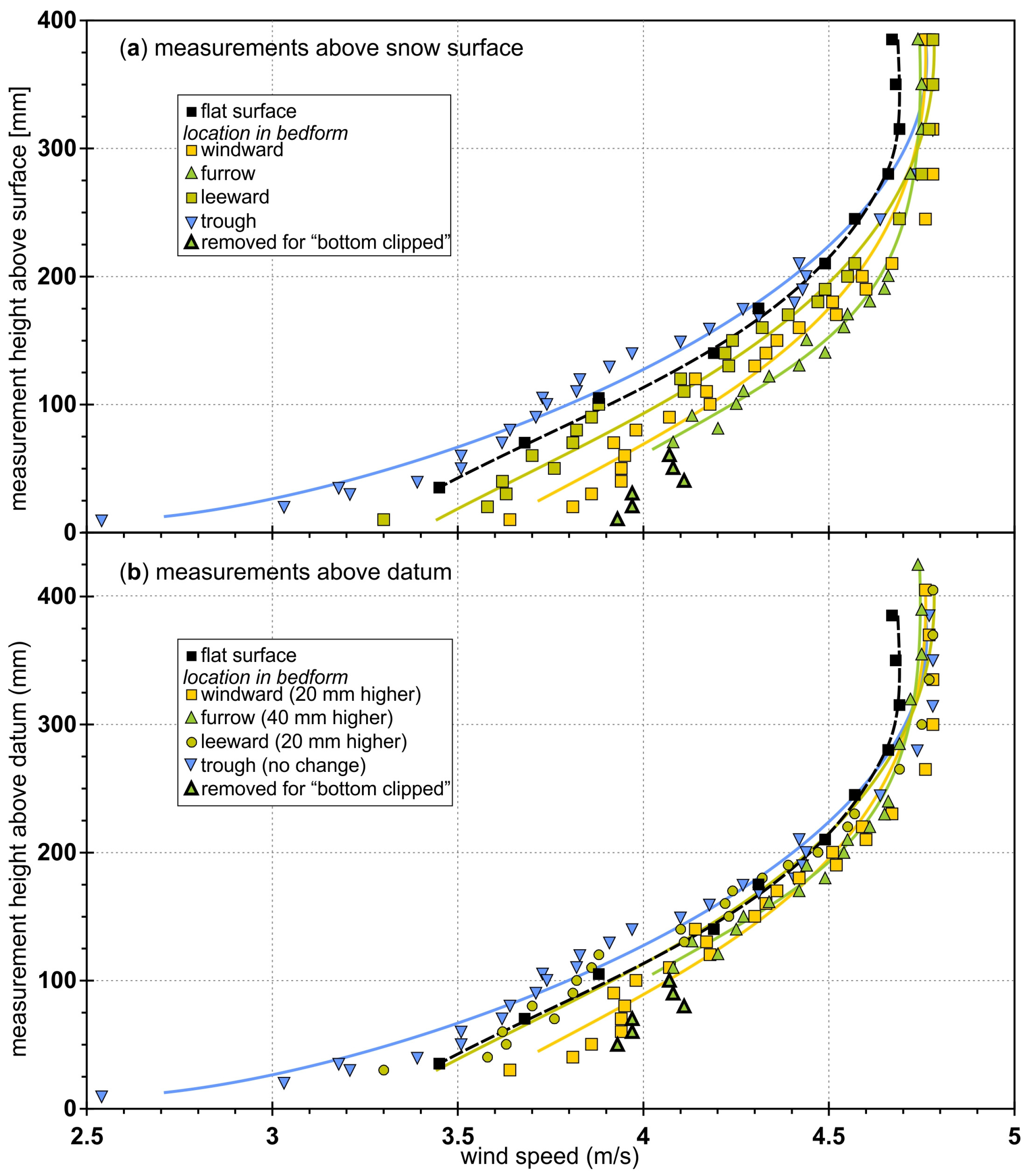
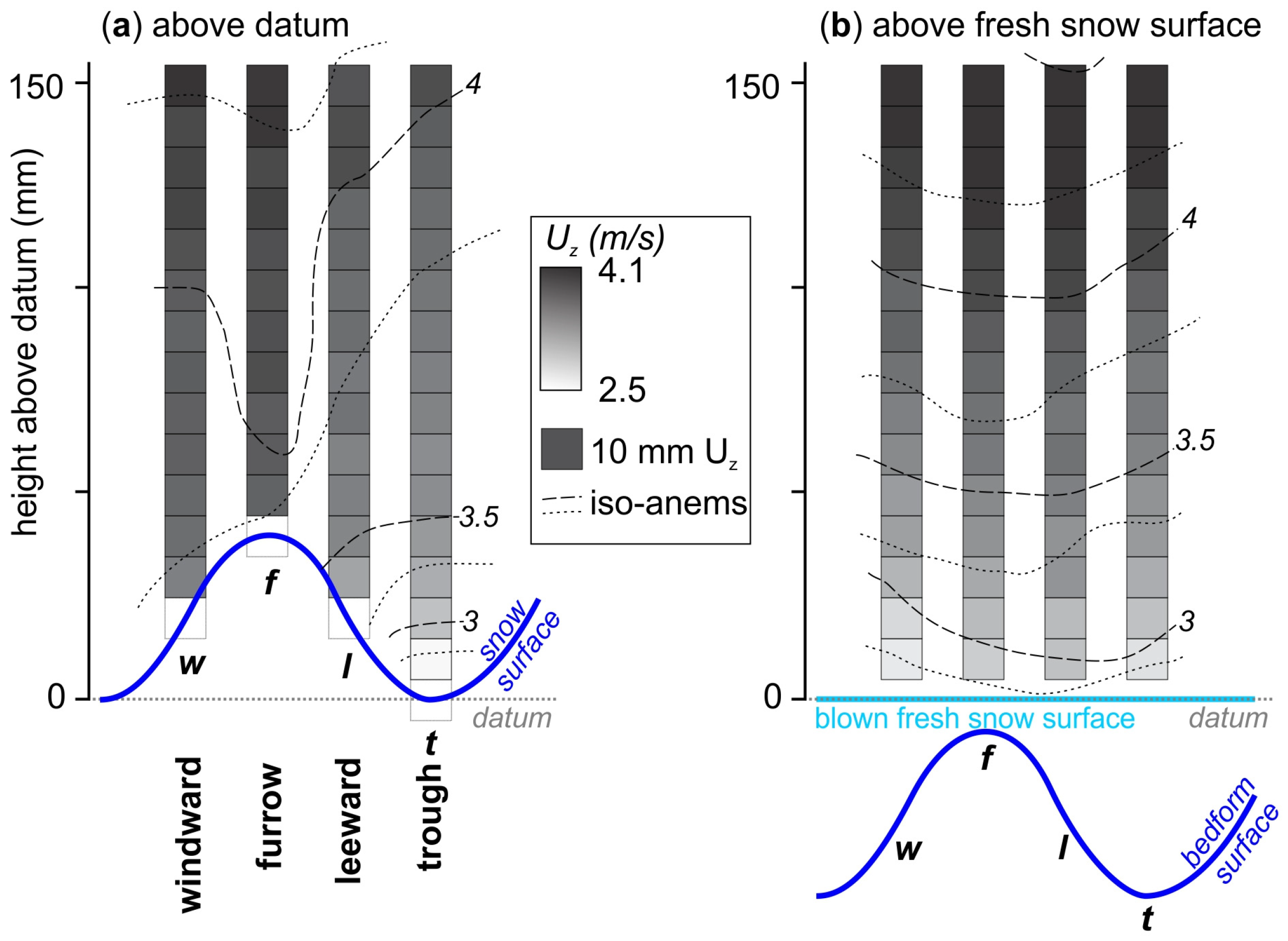
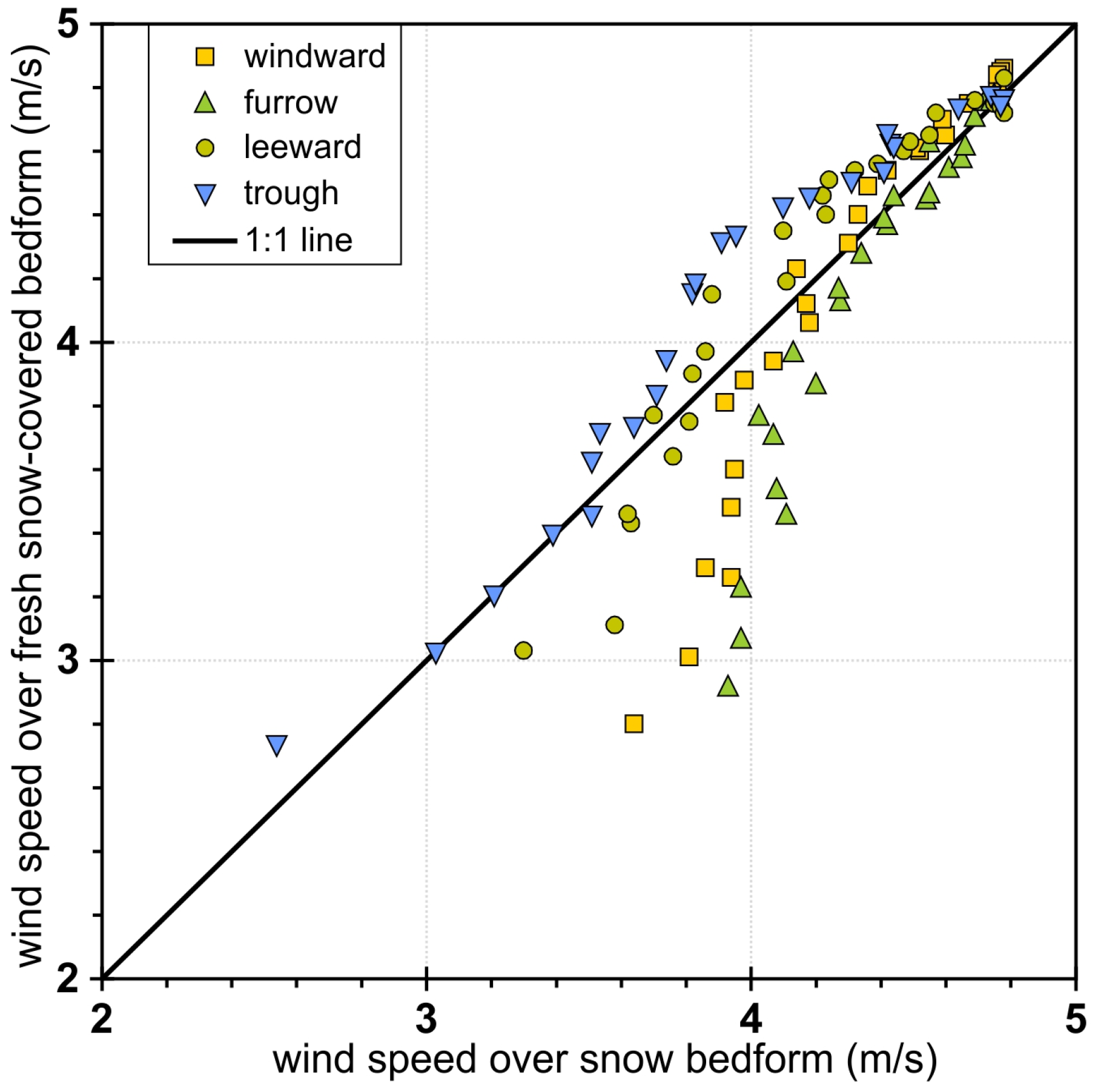

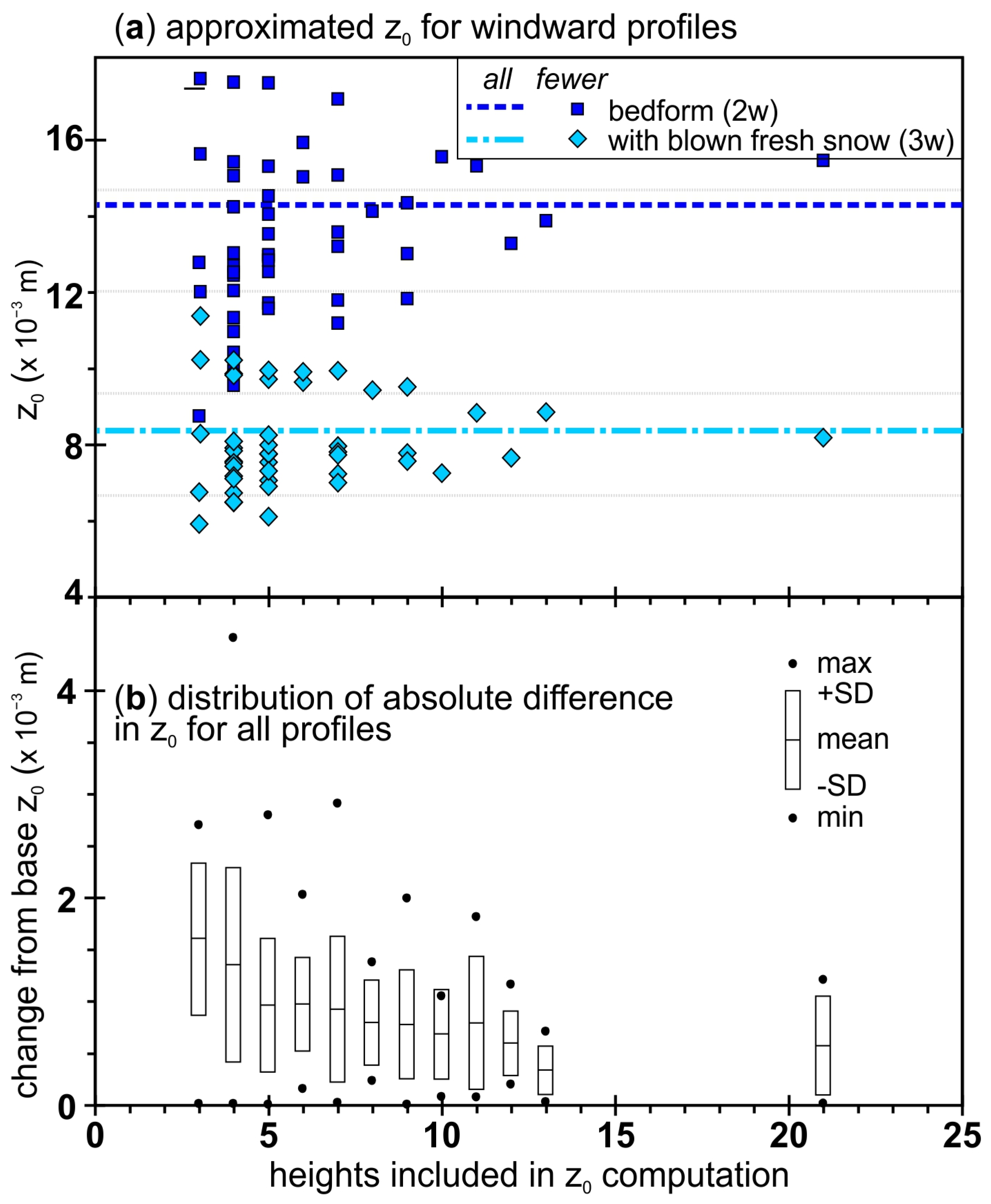
| Experiment | Surface | Figure | Measurement Height (mm) |
|---|---|---|---|
| 1 | flat | Figure 1a | 35–385 by 35 mm increments |
| 2w | Bedform/wave–windward | Figure 1b | 10–210 by 10 mm, then 210–385 by 35 mm |
| 2f | Bedform/wave–furrow (top) | Figure 1b | |
| 2l | Bedform/wave–leeward | Figure 1b | |
| 2t | Bedform/wave–trough (bottom) | Figure 1b | |
| 2wd, 2fd, 2ld, 2td | Wind profile above common datum | Figure 1b | |
| 2fc, 2fdc | Furrow with bottom of profile clipped | Figure 1b | |
| 3w | Fresh snow-covered wave–windward | Figure 1e | |
| 3f | Fresh snow-covered wave–furrow (top) | Figure 1e | |
| 3l | Fresh snow-covered wave–leeward | Figure 1e | |
| 3t | Fresh snow-covered wave–trough (bottom) | Figure 1e |
| Number | Form/Location | z0 (×10−3 m) | R2 | ||
|---|---|---|---|---|---|
| Mean | Low | High | |||
| 1 | Flat | 4.35 | 3.53 | 5.08 | 0.973 |
| Above snow surface | |||||
| 2w | Bedform: windward | 5.35 | 4.26 | 6.26 | 0.852 |
| 3f | Windward on fresh snow drift | 3.18 * | 2.78 | 3.57 | 0.972 |
| 2f | Bedform: furrow (all data) | 5.75 | 4.65 | 6.62 | 0.780 |
| 2fc | Furrow (bottom clipped) | 4.06 # | 3.38 | 4.66 | 0.908 |
| 3f | Furrow on fresh snow drift | 3.60 * | 3.21 | 3.98 | 0.973 |
| 2l | Bedform: leeward | 4.96 | 4.11 | 5.72 | 0.902 |
| 3l | Leeward on fresh snow drift | 3.42 * | 2.94 | 3.89 | 0.960 |
| 2t | Bedform: trough | 4.27 | 3.62 | 4.90 | 0.943 |
| 3t | Trough on fresh snow drift | 3.32 * | 2.88 | 3.74 | 0.970 |
| Above datum set at trough height | |||||
| 2w2 | Windward | 4.50 | 3.72 | 5.18 | 0.912 |
| 2f2 | Furrow (all data) | 4.64 | 3.85 | 5.32 | 0.866 |
| 2fdc | Furrow (bottom clipped) | 3.56 # | 2.86 | 4.18 | 0.899 |
| 2l2 | Leeward | 4.13 | 3.56 | 4.65 | 0.949 |
| 2t2 | Bedform trough | 4.27 | 3.62 | 4.90 | 0.943 |
| z0 Value (mm) | Conditions | Method | Citation |
|---|---|---|---|
| 0.001 to 100 | On ice sheet with some blowing snow | Wind profile | Andreas et al. [5] |
| 0.01 to 70 | Directional over sastrugi | Wind profile | Jackson and Carroll [29] |
| 0.17 to 0.33 | Fresh snow (mean of 0.24) | Geometry | Gromke et al. [28] |
| 0.2 to 2 | Snow on smooth surface | Wind profile | Sanow et al. [8] |
| 1 to 40 | Snow on plowed surface | Wind profile | Sanow et al. [8] |
| 3 to 25 | Snow on plowed surface | Geometry | Sanow et al. [8] |
| 5.5 | Snow on glacier ice | Geometry | Munro [13] |
| 4.4 | Flat snow surface | Wind profile | This study (1) |
| 4.1 to 4.6 | Locations along bedform | Wind profile | This study (exp. 2) |
| 3.2 to 3.6 | Fresh snow on bedforms | Wind profile | This study (exp. 3) |
Disclaimer/Publisher’s Note: The statements, opinions and data contained in all publications are solely those of the individual author(s) and contributor(s) and not of MDPI and/or the editor(s). MDPI and/or the editor(s) disclaim responsibility for any injury to people or property resulting from any ideas, methods, instructions or products referred to in the content. |
© 2024 by the authors. Licensee MDPI, Basel, Switzerland. This article is an open access article distributed under the terms and conditions of the Creative Commons Attribution (CC BY) license (https://creativecommons.org/licenses/by/4.0/).
Share and Cite
Fassnacht, S.R.; Suzuki, K.; Nemoto, M.; Sanow, J.E.; Kosugi, K.; Tedesche, M.E.; Frey, M.M. Location Dictates Snow Aerodynamic Roughness. Glacies 2024, 1, 1-16. https://doi.org/10.3390/glacies1010001
Fassnacht SR, Suzuki K, Nemoto M, Sanow JE, Kosugi K, Tedesche ME, Frey MM. Location Dictates Snow Aerodynamic Roughness. Glacies. 2024; 1(1):1-16. https://doi.org/10.3390/glacies1010001
Chicago/Turabian StyleFassnacht, Steven R., Kazuyoshi Suzuki, Masaki Nemoto, Jessica E. Sanow, Kenji Kosugi, Molly E. Tedesche, and Markus M. Frey. 2024. "Location Dictates Snow Aerodynamic Roughness" Glacies 1, no. 1: 1-16. https://doi.org/10.3390/glacies1010001
APA StyleFassnacht, S. R., Suzuki, K., Nemoto, M., Sanow, J. E., Kosugi, K., Tedesche, M. E., & Frey, M. M. (2024). Location Dictates Snow Aerodynamic Roughness. Glacies, 1(1), 1-16. https://doi.org/10.3390/glacies1010001





